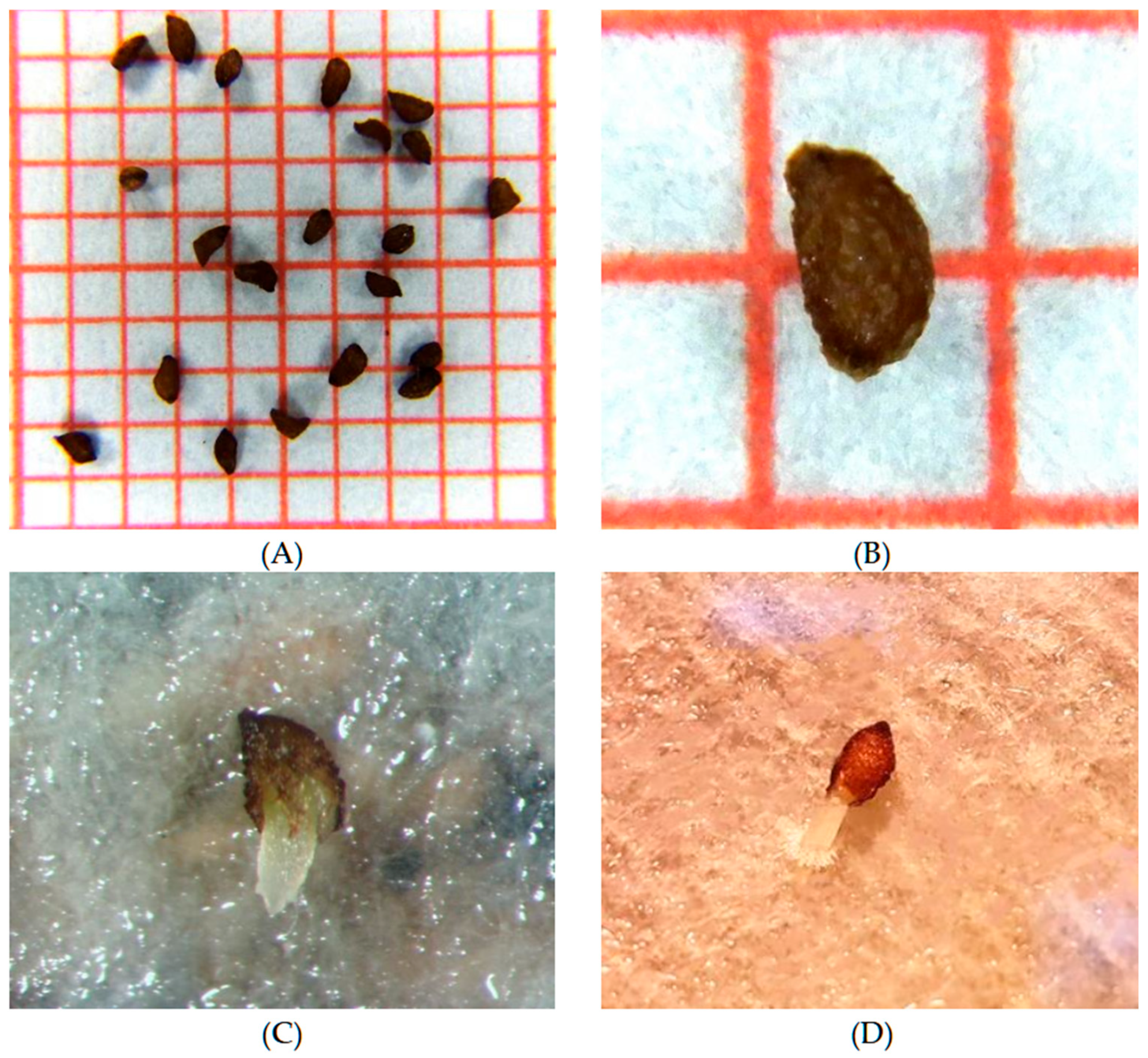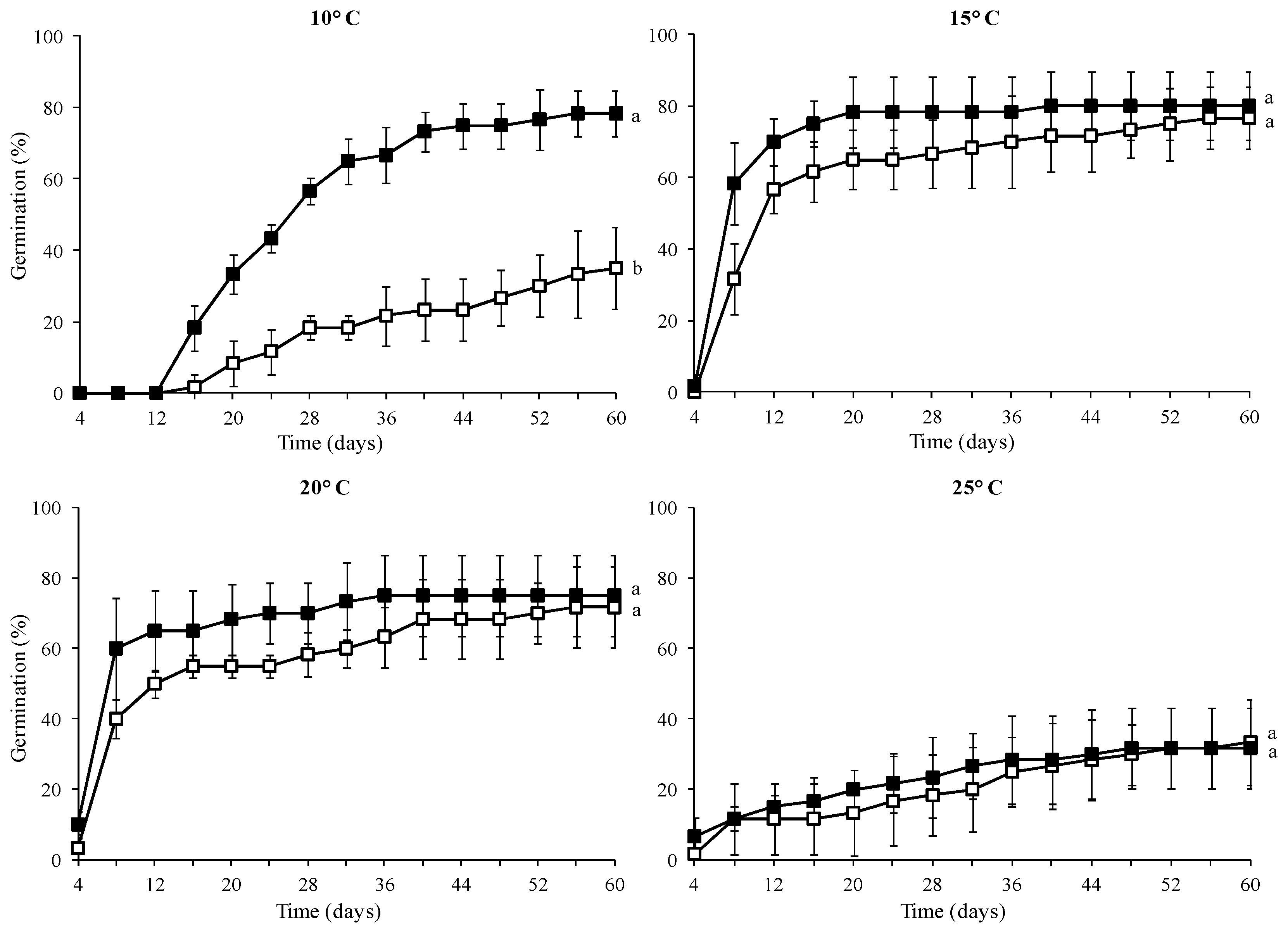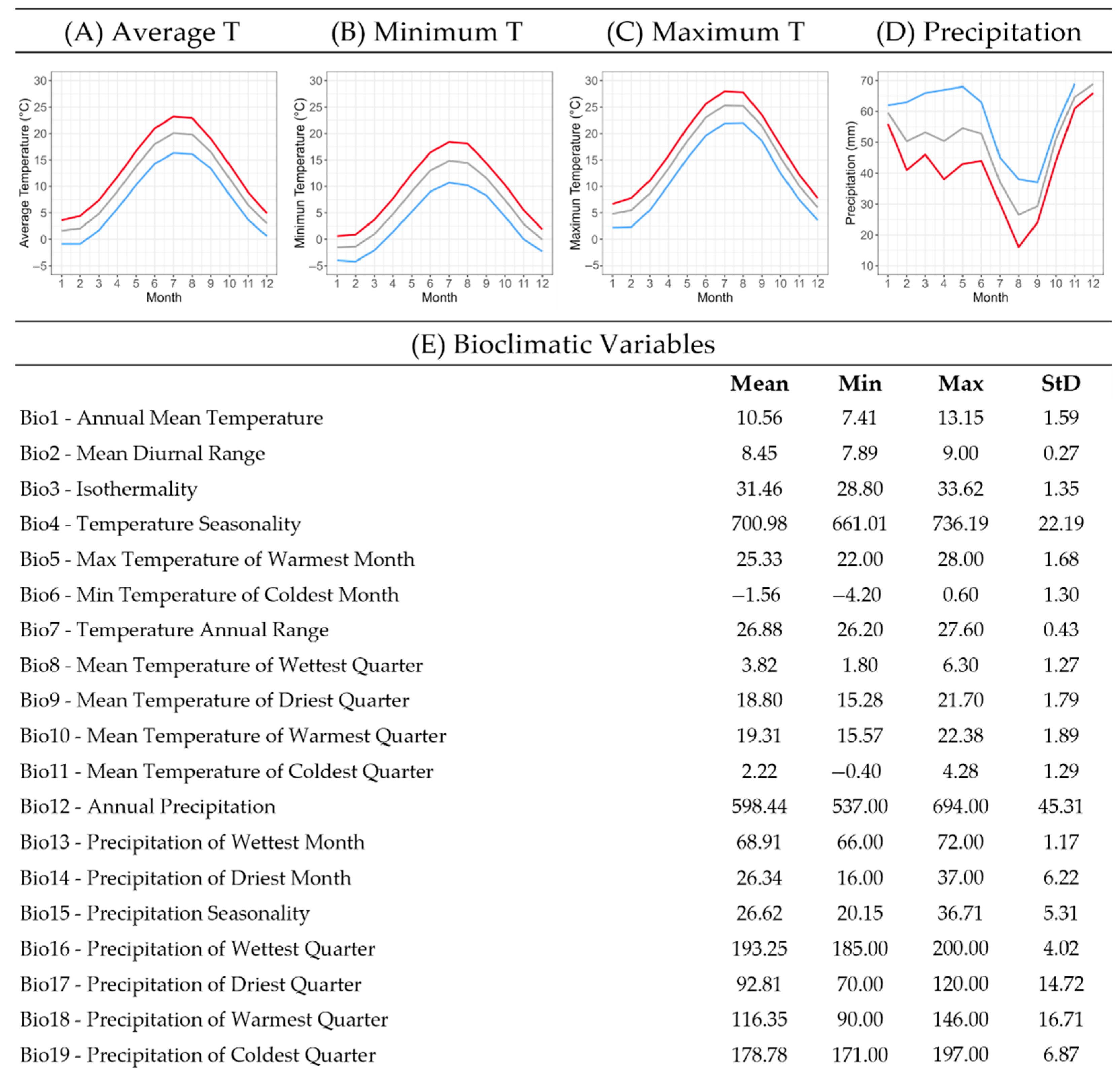Seed Germination Requirements of the Threatened Local Greek Endemic Campanula pangea Hartvig Facilitating Species-Specific Conservation Efforts
Abstract
1. Introduction
2. Materials and Methods
2.1. Seed Collection
2.2. Seed Germination
2.3. Statistical Analysis
2.4. Bioclimatic Profile
3. Results
3.1. Seed Germination
3.2. Bioclimatic Profiling
4. Discussion
5. Conclusions
Author Contributions
Funding
Institutional Review Board Statement
Informed Consent Statement
Data Availability Statement
Acknowledgments
Conflicts of Interest
References
- Heywood, V.H.; Iriondo, J.M. Plant conservation: Old problems, new perspectives. Biol. Conserv. 2003, 113, 321–335. [Google Scholar] [CrossRef]
- Heywood, V.H. Conserving plants within and beyond protected areas—Still problematic and future uncertain. Plant Divers. 2019, 41, 36–49. [Google Scholar] [CrossRef]
- Fenu, G.; Bacchetta, G.; Christodoulou, C.S.; Cogoni, D.; Fournaraki, C.; Gian Pietro, G.d.G.; Gotsiou, P.; Kyratzis, A.; Piazza, C.; Vicens, M.; et al. A common approach to the conservation of threatened island vascular plants: First results in the mediterranean basin. Diversity 2020, 12, 157. [Google Scholar] [CrossRef]
- Krigas, N.; Papadimitriou, K.; Mazaris, D. GIS and ex situ plant conservation. In Applied Geographical Information Systems; Alam, B.M., Ed.; Intech Open: Rijeka, Croatia, 2012; pp. 153–174. ISBN 978-953-51-0824-5. [Google Scholar]
- Radomir, A.-M.; Stan, R.; Florea, A.; Ciobotea, C.-M.; Bănuță, F.M.; Negru, M.; Neblea, M.A.; Sumedrea, D.I. Overview of the success of in vitro culture for ex situ conservation and sustainable utilization of endemic and subendemic native plants of Romania. Sustainability 2023, 15, 2581. [Google Scholar] [CrossRef]
- Maxted, N.; Ford-Lloyd, B.V.; Hawkes, J.G. Complementary conservation strategies. In Plant Genetic Conservation; Maxted, N., Ford-Lloyd, B.V., Hawkes, J.G., Eds.; Springer Netherlands: Dordrecht, The Netherlands, 2000; pp. 15–39. ISBN 978-0-412-63730-8. [Google Scholar]
- Liu, X.; Xiao, Y.; Ling, Y.; Liao, N.; Wang, R.; Wang, Y.; Liang, H.; Li, J.; Chen, F. Effects of seed biological characteristics and environmental factors on seed germination of the critically endangered species Hopea chinensis (Merr.) Hand.-Mazz. in China. Forests 2023, 14, 1975. [Google Scholar] [CrossRef]
- Qaderi, M.M. Environmental regulation of weed seed dormancy and germination. Seeds 2023, 2, 259–277. [Google Scholar] [CrossRef]
- Chen, F.; Liu, L.; Chen, F.; Jia, G. The ecological characteristics of seed germination and seedling establishment of Manglietia patungensis: Implication for species conservation. Am. J. Plant Sci. 2012, 3, 1455–1461. [Google Scholar] [CrossRef]
- Margreiter, V.; Pagitz, K.; Berg, C.; Schwager, P.; Erschbamer, B. Pros and cons of using a standard protocol to test germination of alpine species. Plant Ecol. 2020, 221, 1045–1067. [Google Scholar] [CrossRef]
- Kim, H.M.; Kim, J.H.; Lee, J.H.; Kim, G.M.; Lee, M.H.; Park, C.Y.; Kim, D.H.; Lee, D.H.; Kim, K.M.; Na, C.S. Dormancy-release and germination improvement of korean bellflower (Campanula takesimana Nakai), a rare and endemic plant native to the Korean peninsula. PLoS ONE 2023, 18, e0292280. [Google Scholar] [CrossRef]
- Bewley, J. Seed germination and dormancy. Plant Cell 1997, 9, 1055–1066. [Google Scholar] [CrossRef]
- Soltani, E.; Baskin, C.C.; Gonzalez-Andujar, J.L. An overview of environmental cues that affect germination of nondormant seeds. Seeds 2022, 1, 146–151. [Google Scholar] [CrossRef]
- Miransari, M.; Smith, D.L. Plant hormones and seed germination. Environ. Exp. Bot. 2014, 99, 110–121. [Google Scholar] [CrossRef]
- Bewley, J.D.; Bradford, K.J.; Hilhorst, H.W.M.; Nonogaki, H. Seeds: Physiology of Development, Germination and Dormancy, 3rd ed.; Springer: New York, NY, USA, 2013; ISBN 978-1-4614-4692-7. [Google Scholar]
- Klupczyńska, E.A.; Pawłowski, T.A. Regulation of seed dormancy and germination mechanisms in a changing environment. Int. J. Mol. Sci. 2021, 22, 1357. [Google Scholar] [CrossRef]
- Penfield, S.; MacGregor, D.R. Effects of environmental variation during seed production on seed dormancy and germination. J. Exp. Bot. 2017, 68, 819–825. [Google Scholar] [CrossRef]
- Dadlani, M.; Yadava, D.K. Seed Science and Technology: Biology, Production, Quality; Springer Nature: Singapore, 2023; ISBN 978-981-19-5888-5F. [Google Scholar]
- Finch-Savage, W.E.; Leubner-Metzger, G. Seed dormancy and the control of germination. New Phytol. 2006, 171, 501–523. [Google Scholar] [CrossRef]
- Mayer, A.M.; Poljakoff-Mayber, A. The Germination of Seeds, 3rd ed.; Mayer, A.M., Poljakoff-Mayber, A., Eds.; Elsevier: Amsterdam, The Netherlands, 1982; ISBN 0-08-028854-5. [Google Scholar]
- Haj Sghaier, A.; Tarnawa, Á.; Khaeim, H.; Kovács, G.P.; Gyuricza, C.; Kende, Z. The effects of temperature and water on the seed germination and seedling development of rapeseed (Brassica napus L.). Plants 2022, 11, 2819. [Google Scholar] [CrossRef]
- Koornneef, M.; Bentsink, L.; Hilhorst, H. Seed dormancy and germination. Curr. Opin. Plant Biol. 2002, 5, 33–36. [Google Scholar] [CrossRef]
- Carrera-Castaño, G.; Calleja-Cabrera, J.; Pernas, M.; Gómez, L.; Oñate-Sánchez, L. An updated overview on the regulation of seed germination. Plants 2020, 9, 703. [Google Scholar] [CrossRef] [PubMed]
- Adkins, S.W.; Bellairs, S.M.; Loch, D.S. Seed dormancy mechanisms in warm season grass species. Euphytica 2002, 126, 13–20. [Google Scholar] [CrossRef]
- Baskin, C.C.; Baskin, J.M. Seeds: Ecology, Biogeography, and Evolution of Dormancy and Germination, 2nd ed.; Academic Press: San Diego, CA, USA, 2014; ISBN 978-0-12-416677-6. [Google Scholar]
- Ma, H.-Y.; Zhao, D.-D.; Ning, Q.-R.; Wei, J.-P.; Li, Y.; Wang, M.-M.; Liu, X.-L.; Jiang, C.-J.; Liang, Z.-W. A multi-year beneficial effect of seed priming with gibberellic acid-3 (GA3) on plant growth and production in a perennial grass, Leymus chinensis. Sci. Rep. 2018, 8, 13214. [Google Scholar] [CrossRef] [PubMed]
- Du, G.; Zhang, H.; Yang, Y.; Zhao, Y.; Tang, K.; Liu, F. Effects of gibberellin pre-treatment on seed germination and seedling physiology characteristics in industrial hemp under drought stress condition. Life 2022, 12, 1907. [Google Scholar] [CrossRef]
- Lammers, T.G. World Checklist and Bibliography of Campanulaceae; Kew Publishing, Royal Botanic Gardens, Kew: Richmond, UK, 2007. [Google Scholar]
- Bramley, G.; Trias-Blasi, A.; Wilford, R. The Kew Temperate Plant Families Identification Handbook; Kew Publishing, Royal Botanic Gardens, Kew: Richmond, UK, 2023. [Google Scholar]
- Lammers, T.G. Campanulaceae: Campanulaceae Jussieu, Gen. Pl. 163 (1789), Nom. Cons. In Flowering Plants Eudicots; Kadereit, J.W., Jeffrey, C., Eds.; Springer: Berlin/Heidelberg, Germany, 2007; pp. 26–56. ISBN 978-3-540-31051-8. [Google Scholar]
- Campanula L. Plants of the World Online. Facilitated by the Royal Botanic Gardens, Kew. Available online: https://powo.science.kew.org/ (accessed on 23 May 2025).
- Seglie, L.; Scariot, V.; Larcher, F.; Devecchi, M.; Chiavazza, P.M. In vitro seed germination and seedling propagation in Campanula spp. Plant Biosyst. 2012, 146, 15–23. [Google Scholar] [CrossRef]
- Liveri, E.; Crowl, A.A.; Cellinese, N. Past, Present and future of Campanula (Campanulaceae) systematics—A review. Bot. Chron. 2019, 22, 209–222. [Google Scholar]
- Koutsovoulou, K.; Daws, M.I.; Thanos, C.A. Campanulaceae: A family with small seeds that require light for germination. Ann. Bot. 2014, 113, 135–143. [Google Scholar] [CrossRef]
- Hartvig, P. Campanula pangea, a new species of C. Sect. Involucratae from Mt Pangeon, NE Greece. Willdenowia 1998, 28, 65–68. [Google Scholar] [CrossRef][Green Version]
- Krigas, N.; Constantinidis, T. Campanula pangea Hartvig, Vulnerable (VU). In The Red Data Book of Rare and Threatened Plants of Greece; Hellenic Botanical Society: Patras, Greece, 2009; Volume 1 (A–D). [Google Scholar]
- Liveri, E.; Paradisioti, M.; Tsiripidis, I. Campanula pangea. Available online: https://www.iucnredlist.org/species/224625769/225911626 (accessed on 21 May 2025).
- Panagiotidou, T.-N.; Anestis, I.; Pipinis, E.; Kostas, S.; Tsoktouridis, G.; Hatzilazarou, S.; Krigas, N. GIS Bioclimatic profile and seed germination of the endangered and protected Cretan endemic plant Campanula cretica (A. DC.) D. Dietr. for conservation and sustainable utilization. Agriculture 2025, 15, 1161. [Google Scholar] [CrossRef]
- Paradisiotis, M. Conservation Status Assessment and Establishment of Monitoring Scheme for the Local Endemic Species Campanula pangea by Employing Individual-Based Functional Trait Measurements. Master’s Thesis, Aristotle University of Thessaloniki, Thessaloniki, Greece, 2024. [Google Scholar]
- Fick, S.E.; Hijmans, R.J. WorldClim 2: New 1-km spatial resolution climate surfaces for global land areas. Int. J. Climatol. 2017, 37, 4302–4315. [Google Scholar] [CrossRef]
- R Core Team. R: A Language and Environment for Statistical Computing. 2023. Available online: https://www.r-project.org/ (accessed on 10 May 2025).
- Posit Team RStudio: Integrated Development Environment for R. 2023. Available online: https://posit.co/downloads/ (accessed on 10 May 2025).
- Hijmans, R.J.; Barbosa, M.; Ghosh, A.; Mandel, A. Geodata: Download Geographic Data. 2024. Available online: https://CRAN.R-project.org/package=geodata (accessed on 10 May 2025).
- Villanueva, R.A.M.; Chen, Z.J. ggplot2: Elegant graphics for data analysis (2nd Ed.). Meas-Interdiscip. Res. 2019, 17, 160–167. [Google Scholar] [CrossRef]
- Soltani, E.; Baskin, C.C.; Baskin, J.M. A graphical method for identifying the six types of non-deep physiological dormancy in seeds. Plant Biol. 2017, 19, 673–682. [Google Scholar] [CrossRef] [PubMed]
- Anestis, I.; Pipinis, E.; Kostas, S.; Papaioannou, E.; Karapatzak, E.; Dariotis, E.; Tsoulpha, P.; Koundourakis, E.; Chatzileontari, E.; Tsoktouridis, G.; et al. GIS-facilitated germination of stored seeds from five wild-growing populations of Campanula pelviformis Lam. and fertilization effects on growth, nutrients, phenol content and antioxidant potential. Horticulturae 2023, 9, 877. [Google Scholar] [CrossRef]
- Hatzilazarou, S.; Anestis, I.; Pipinis, E.; Kostas, S.; Avramakis, M.; Greveniotis, V.; Dariotis, E.; Tsoktrouridis, G.; Krigas, N. GIS-facilitated seed germination of six local endemic plants of Crete (Greece) and multifaceted evaluation in three economic sectors. J. Biol. Res. Thessalon. 2023, 30, 5. [Google Scholar] [CrossRef]
- Yücel, G.; Erken, K. Optimal germination methods, ornamental plant features, and ex situ conservation of endemic Campanula grandis Fisch & C.A. Mey. J. Environ. Eng. Landsc. Manag. 2023, 31, 132–141. [Google Scholar] [CrossRef]
- Giménez-Benavides, L.; Escudero, A.; Pérez-García, F. Seed germination of high mountain mediterranean species: Altitudinal, interpopulation and interannual variability. Ecol. Res. 2005, 20, 433–444. [Google Scholar] [CrossRef]
- Anestis, I.; Pipinis, E.; Karapatzak, E.; Kostas, S.; Menexes, G.; Dariotis, E.; Tsoktouridis, G.; Hatzilazarou, S.; Krigas, N. Effect of genotype and altitude on the germination of freshly collected seeds from wild-growing populations of Campanula pelviformis Lam. and Petromarula pinnata (L.) A. DC. (Campanulaceae). Horticulturae 2024, 10, 1149. [Google Scholar] [CrossRef]




| Source | Sum of Squares | Df | Mean Square | F | p Value |
|---|---|---|---|---|---|
| Temperature | 10,248.65 | 3 | 3416.22 | 31.39 | 0.000 |
| GA3 | 1168.01 | 1 | 1168.01 | 10.73 | 0.003 |
| Temperature × GA3 | 2637.41 | 3 | 879.14 | 8.08 | 0.001 |
| Treatment | Incubation Temperature | |||
|---|---|---|---|---|
| 10 °C | 15 °C | 20 °C | 25 °C | |
| Control | 35.00 b 1 ± 11.38 | 76.67 a ± 8.61 | 71.67 a ± 11.39 | 33.34 b ± 12.17 |
| 1000 ppm GA3 | 78.33 a ± 6.39 | 80.00 a ± 9.43 | 75.00 a ± 11.39 | 31.37 b ± 11.39 |
Disclaimer/Publisher’s Note: The statements, opinions and data contained in all publications are solely those of the individual author(s) and contributor(s) and not of MDPI and/or the editor(s). MDPI and/or the editor(s) disclaim responsibility for any injury to people or property resulting from any ideas, methods, instructions or products referred to in the content. |
© 2025 by the authors. Licensee MDPI, Basel, Switzerland. This article is an open access article distributed under the terms and conditions of the Creative Commons Attribution (CC BY) license (https://creativecommons.org/licenses/by/4.0/).
Share and Cite
Paradisiotis, M.; Pipinis, E.; Kostas, S.; Tsoktouridis, G.; Hatzilazarou, S.; Mastrogianni, A.; Tsiripidis, I.; Krigas, N. Seed Germination Requirements of the Threatened Local Greek Endemic Campanula pangea Hartvig Facilitating Species-Specific Conservation Efforts. Conservation 2025, 5, 39. https://doi.org/10.3390/conservation5030039
Paradisiotis M, Pipinis E, Kostas S, Tsoktouridis G, Hatzilazarou S, Mastrogianni A, Tsiripidis I, Krigas N. Seed Germination Requirements of the Threatened Local Greek Endemic Campanula pangea Hartvig Facilitating Species-Specific Conservation Efforts. Conservation. 2025; 5(3):39. https://doi.org/10.3390/conservation5030039
Chicago/Turabian StyleParadisiotis, Margarita, Elias Pipinis, Stefanos Kostas, Georgios Tsoktouridis, Stefanos Hatzilazarou, Anna Mastrogianni, Ioannis Tsiripidis, and Nikos Krigas. 2025. "Seed Germination Requirements of the Threatened Local Greek Endemic Campanula pangea Hartvig Facilitating Species-Specific Conservation Efforts" Conservation 5, no. 3: 39. https://doi.org/10.3390/conservation5030039
APA StyleParadisiotis, M., Pipinis, E., Kostas, S., Tsoktouridis, G., Hatzilazarou, S., Mastrogianni, A., Tsiripidis, I., & Krigas, N. (2025). Seed Germination Requirements of the Threatened Local Greek Endemic Campanula pangea Hartvig Facilitating Species-Specific Conservation Efforts. Conservation, 5(3), 39. https://doi.org/10.3390/conservation5030039








